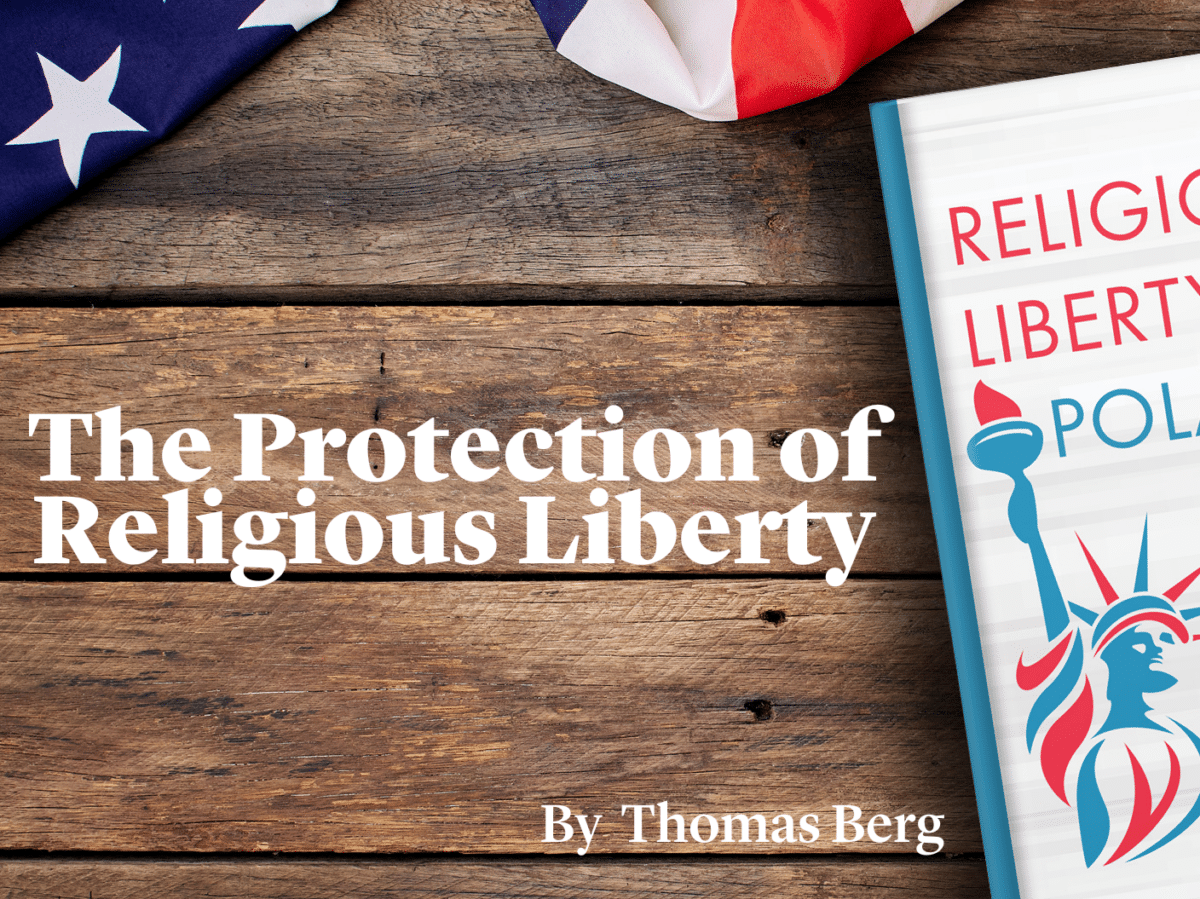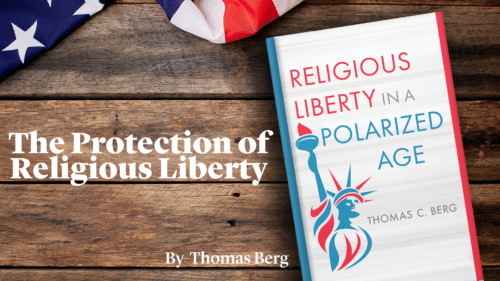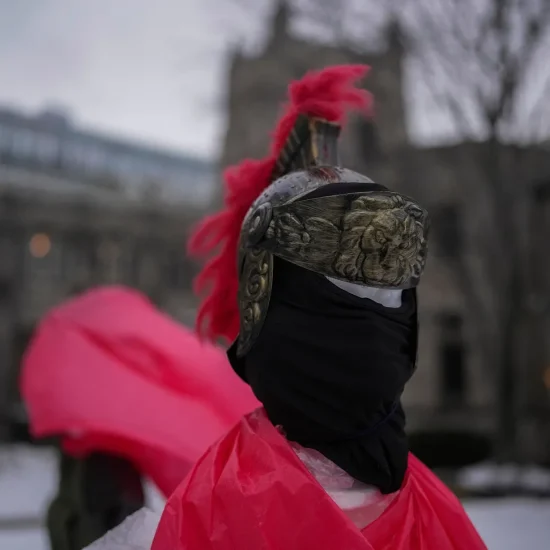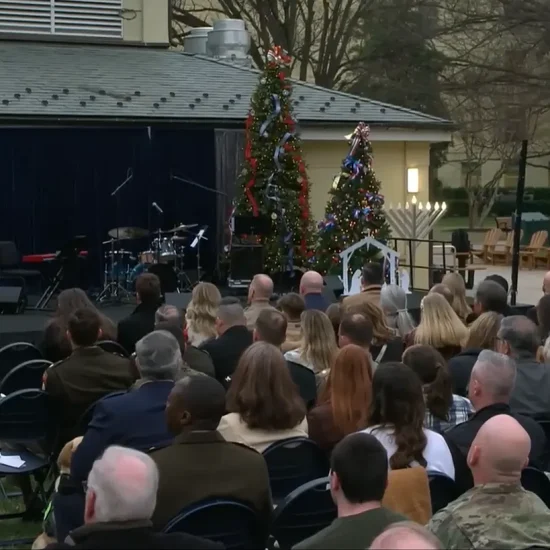

RELIGIOUS LIBERTY IN A POLARIZED AGE. By Thomas C. Berg. Grand Rapids, MI: Wm. B. Eerdmans Publishing Company, 2023. Xii + 359.
There is a lot of talk these days about religious liberty and religious freedom in the United States. It is part of our ongoing political, cultural, and legal conversation. Numerous cases involving important matters of church and state have appeared before the Supreme Court in recent years, and many more are on the horizon. It appears, based on recent rulings, that the current court is apt to side with religious claimants. Some of those decisions are worrying to many who want to make sure that the proper boundaries between church and state remain in place. While some of these recent rulings have been helpful, others have troubling consequences. As with many other areas of life, the populace is divided. The question is: How should we understand and respond appropriately to matters of religious freedom lying in front of us? For those of us who are adherents of a religious tradition, the outcome of these debates and rulings can have an impact on our lives. So how should we proceed?

Robert D. Cornwall
Thomas Berg offers us an important analysis and set of suggestions that address the concerns in his recently published book Religious Liberty in a Polarized Age, the most recent contribution to the Emory University Studies in Law and Religion series. Berge serves as the James L. Oberstar Professor of Law and Public Policy at the University of St. Thomas School of Law in Minnesota. In addition to his teaching duties, he has served as an advocate and advisor to numerous groups as they seek redress in the courts. Thus, he brings both scholarly and practical insight to the questions at hand. He is committed to supporting religious freedom in the United States, but he also understands the limits to that freedom.
As Berg demonstrates in this book there is often a fine line between religious freedom and the rights and concerns of those affected by claimants of religious freedom. We’re seeing that play out in our courts. It should be noted that in any book dealing with current debates, there will have been developments that have emerged since the manuscript went to the publisher. In this case, Berg wrote the preface to the book in December 2022. Thus, he wrote before the Dobbs decision overturning Roe v. Wade was made by the Supreme Court. Other decisions have been made since then. So, this doesn’t cover every issue, but it does provide us with a lens to view decisions that continue to be made by the courts and the impact of those decisions on our lives.
Berg covers a lot of ground in Religious Liberty in a Polarized Age. He offers important guidance on matters that range from the intersection of LGBTQ rights and traditionalist religious perspectives to the rights of minority religions in the United States. He offers sharp and sometimes words for folks on both the left and right; religious and non-religious. As I read the book, I quickly realized that certain recommendations might not sit well with some of my friends. However, there is likely a need for balance if the polarization so prominent in our society is to be overcome so that we can move forward in respecting the rights and needs of everyone.
As one might expect, much of the focus of the book centers on the Supreme Court since it’s this Court has become the final destination of the debates over religious liberty and individual rights. Berg points out that the “bitterness of religious-liberty disputes arises from, but also feeds into, the overall bitter polarization of our society” (p. 4). I think we can agree with that analysis.
Thomas Berg divides Religious Liberty in a Polarized Age into three parts. The first two chapters, found in Part 1 provide an overview of “the problem of polarization and religious liberty.” He begins with a chapter laying out the current situation facing us in a “Polarized America,” including religious divides. He does this by laying out the full set of concerns that threaten the nation’s viability. He concludes the chapter by noting that “because so many scenarios are bad, it is worth considering all possible resources for mitigating polarization—including the resource of our tradition of religious freedom” (p. 54). Having laid out the current crisis of polarization in the United States, he moves on in Chapter 2 to the specific issues that have emerged due to the “Polarization on Religious-Liberty Issues.” In this chapter, Berg focuses on three sets of religious-liberty issues. The first area of concern is discrimination against Muslim individuals and organizations that have been supported by conservative Christians. Secondly, there is the opposition of progressives to meaningful protections for traditionalist religious organizations when it comes to conflicts between LGBTQ nondiscrimination laws. Finally, there are conflicts over religious meetings during the COVID-19 pandemic. He notes that the pattern of religious liberty disputes has not only contributed to the overall sorting out of political positions, but they have aggravated them. The irony here is that the American tradition of religious liberty is supposed to calm such concerns.
While Part 1 lays out the basic areas of concern, Part 2 of the book offers the primary arguments for religious freedom. This section of the book offers us three chapters in which Thomas Berg seeks to lay out his arguments for protecting the religious liberty of all Americans (that would include the freedom of those who do not believe). He begins in Chapter 3 by arguing for recognition of how religion is, for many in the United States, a pervasive element in their personal identity. That is, if a person’s ability to live out their faith is curtailed this causes them harm. That is an important reason why the Founders sought to protect religious liberty. He concludes that “we desperately need to exercise more sympathy across ideological lines concerning pressures against people’s identity and integrity. That applies to pressures against Hmong and other religious minorities, atheist plaintiffs, same-sex couples, and religious traditionalists.” He writes that we tend to “dismiss the important identity features of people with whom we disagree, while upholding those with whom we agree.” This pattern further drives the wedge of polarization in our society (p. 118).
Building on this analysis Berg turns in Chapter 4 to offer an argument as to why protecting religious freedom can help reduce fear, alienation, and division in American society. The final chapter in Part 2 argues for the role of religious involvement and the freedom to serve and contribute to the common good. Here, Berg emphasizes the contributions made by people of faith and faith-based institutions. While he lays out how religious communities can and do contribute to the common good, he also acknowledges the damage done when such groups fail to contribute to the common good. In this chapter, Berg cautions white evangelicals especially, who are the most resistant to respecting the pluralism present in the nation. The goal of the chapter is to encourage people of faith to treat religious freedom as the foundation for the freedom to serve.
Part 3 brings Berg’s Religious Liberty in a Polarized Age to a close. In this final section of the book, Berg focuses on what he believes are the “Principles of Religious Freedom.” This section contains four chapters that offer ways in which “strong religious freedom for all” can be translated into concrete principles of law. The first chapter in this section offers a primer on the Constitution’s free-exercise principles. These principles, according to Berg, if they are to fulfill their objective, must, first of all, provide a standard of protection of religious liberty that applies to all religious traditions. In other words, if religious freedom is to work in the United States, a person or group cannot claim freedom for one’s own beliefs and practices and then seek to deny them to others (Berg shows in the book that white evangelicals have exhibited this tendency by arguing for their own religious liberties while opposing the rights of Muslims).
Second, laws have to protect religious liberty from all sources of threat. Finally, “Religious freedom must have boundaries set by the interests of others and of society. Without such boundaries, religious-freedom protections lose credibility and ultimately, staying power” (p. 188). Examples can be nondiscrimination laws for LGBTQ persons that offer exemptions for religious persons/communities. Here there is a fine line that is difficult to maintain, as many of my LGBTQ friends have discovered. Having laid out general principles in Chapter 6, Berg moves to the need for legal protections for minority faith communities. Here he puts the primary focus on attempts to place restrictions on Muslims (other faith traditions can probably add their own witness). Here he argues that it is in the best interests of conservative Christians to support the religious freedom of Muslims and other religious minorities. If they argue against such freedoms, they undermine their own religious liberty claims. He also addresses religious progressives like me, suggesting that in our support for religious minorities, it is wise to recognize that conservative Christians can at times be a vulnerable minority. The examples he gives include decisions by colleges and universities to bar Christian groups from meeting on university property, while other nonreligious groups are provided such locations.
In this chapter, Berg addresses several topics that arrange from allowing beards for Muslims to the use of peyote in Native American rituals as well as providing appropriate foods in prison for persons with religiously restrictive diets. In Chapter 8, Berg addresses the need to balance LGBTQ rights and religious freedom. This is a challenging chapter that won’t make everyone happy. I understand the need for exceptions for religious schools and other nonprofits along with religious communities when it comes to recognizing LGBTQ rights. While challenges to exceptions often use racial/ethnic discrimination laws as a parallel, Berg suggests that a better analogy is religious freedom. He addresses the concern that many have after the Dobbs decision on abortion, that similar arguments could be used to undermine Oberkfell. He addresses these and suggests that while it is appropriate to have this fear, Obergefell and Dobbs are different in nature. However, since we’re seeing attacks on the rights of LGBTQ folks, especially transgender people, this chapter is going to be a challenge. When it comes to religious concerns regarding LGBTQ rights, including same-sex marriage, I noticed that he didn’t discuss the fact that before Obergefell, the rights of Progressive religious communities were not respected. That is, we could perform commitment ceremonies but not marriages. Nevertheless, whether his solutions are acceptable will be seen in if and how they work out in practice. Berg argues for protecting the rights of both sides, but it’s not easy to accomplish. Berg believes that by providing appropriate religious exemptions, some of the polarization surrounding these areas of conflict could be calmed.
Finally, in chapter 9, Berg addresses government religious speech ranging from prayers at civic and legislative events to school prayers. As one who has prayed/given invocations at civic events, I am implicated in this conversation. While SCOTUS has affirmed the propriety of prayers in legislative settings, Berg believes some of the rulings have gone too far. He also notes the issue of school prayers remains largely unresolved. The question here revolves around the challenge of government endorsement of religion, especially when that endorsement often involves a majority faith (Christianity). The question we face in such matters is how to avoid coercion. It’s one thing for a self-led student group to meet for prayer and bible study and another for schools to open the day with a prescribed prayer led by a teacher.
As Thomas Berg brings Religious Freedom in a Polarized Age to a close, a book that I found, by and large, to be extremely insightful and helpful, he notes the ironies involved in the debate over the protection of religious freedom. One irony he lifts up has to do with evangelical claims that Muslims are threats to society and have sought to impose restrictions on Muslim practices, and travel, along with calling for surveillance of Muslim communities, when the same concerns leveled at Muslims by evangelicals are those offered by Progressives against religious conservatives, since many Progressives claim that religious conservativism is nothing more than a religious covering for a bigoted political movement. The divisive issues still on the table concern abortion and what happens after Dobbs. Here again, the issue is complicated, especially since religious communities are not of one mind. Conservative Christians might argue for the need to protect the life of the unborn, even at the risk to the life of the mother, while Jews would argue for protecting the life of the mother. When we face such questions, we need to ask whose religious rights are at risk.
There are, Berg believes, paths to bring a sense of calm to the current crisis facing the nation. Finding a path forward that will bring that sense of calm will not be easy. One possible example of an effort to find a balance between competing rights is an effort in Utah to protect LGBTQ rights as well as those of religiously conservative citizens. He believes that a commitment to religious freedom can help in these solutions if that commitment is strong, treats all faith evenhandedly, and remains mindful of other interests” (p. 343). It’s not an easy path to take but it is necessary that we carefully address these concerns if our country is going to avoid dividing into warring factions (we’re already hearing talk of a civil war). While I struggled with the chapter dealing with LGBTQ concerns because I have friends and family members who are affected, overall, I believe Berg’s effort to address the concerns of our day can serve as an important contribution to a much-needed conversation that can lead us beyond the current polarization. We will never find complete agreement, but if we are to truly embrace religious freedom, then it must be religious freedom for all. Then, as Berg concludes, “religious freedom can again play its historic role of stopping cycles of suffering, fear, and resentment” (p. 343).
This review originally appeared on BobCornwall.com.
Robert D. Cornwall is an ordained minister in the Christian Church (Disciples of Christ). Now retired from his ministry at Central Woodward Christian Church (Disciples of Christ) of Troy, Michigan, he serves as Minister-at-Large in Troy. He holds a Ph.D. in Historical Theology from Fuller Theological Seminary and is the author of numerous books including his latest “Second Thoughts about the Second Coming: Understanding the End Times, Our Future, and Christian Hope” coauthored with Ronald J. Allen. His blog Ponderings on a Faith Journey can be found at www.bobcornwall.com.






